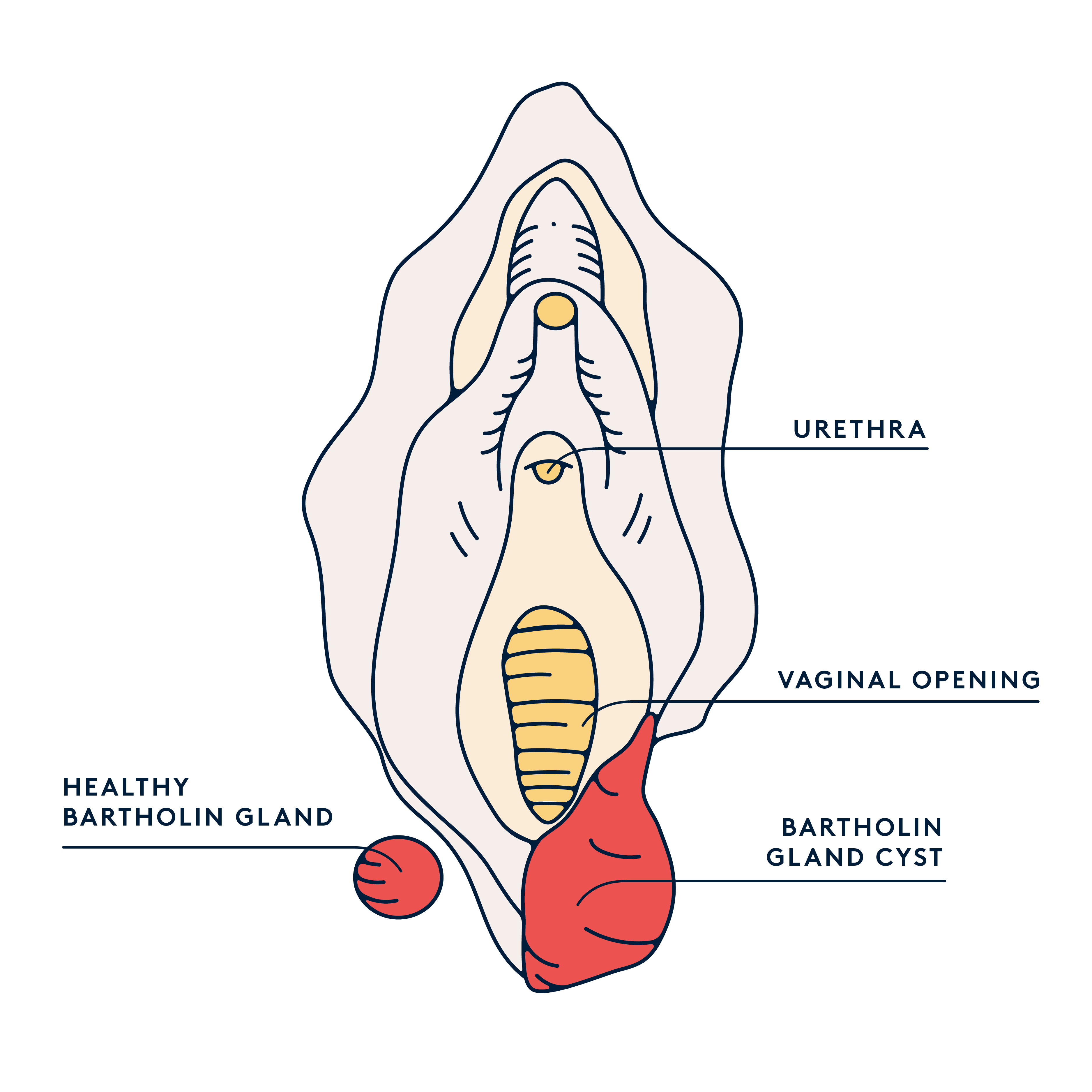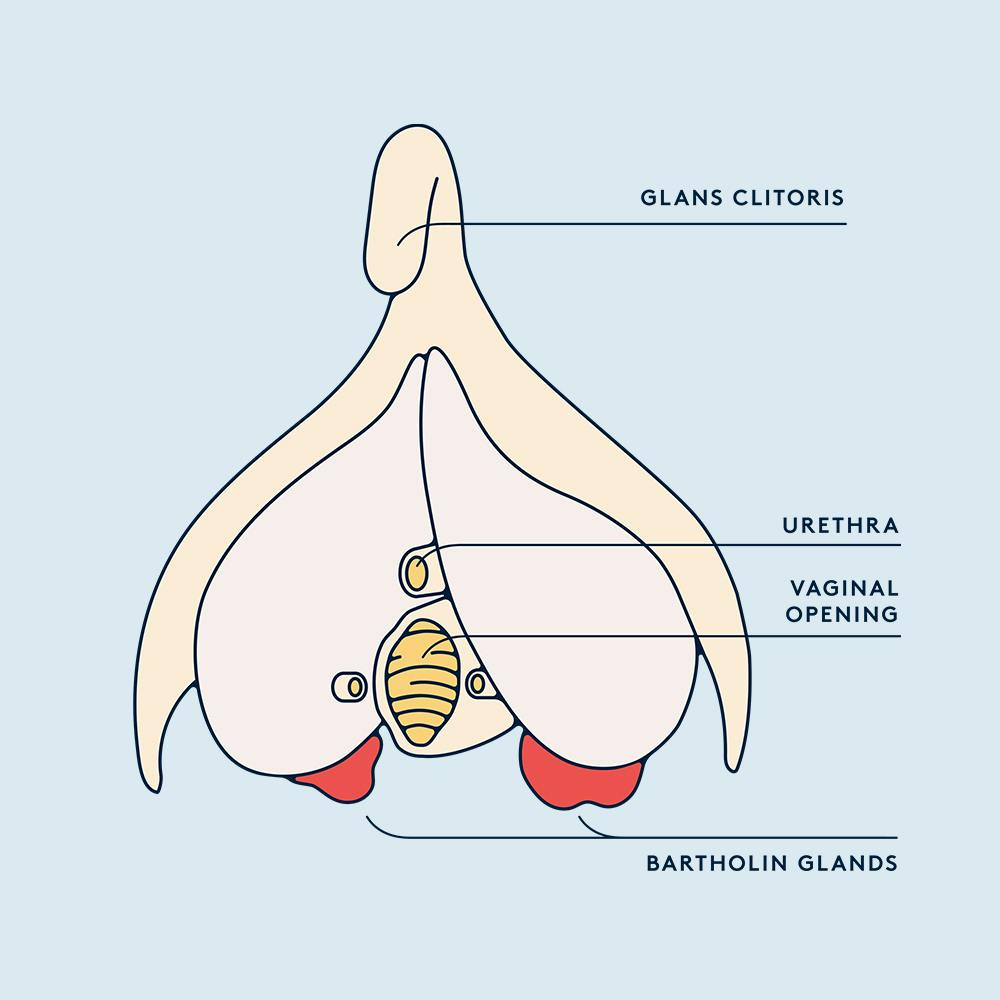Table of contents
1. Finding a lump on your vulva can send you into a panicked Google search spiral, but not every bump is cause for concern.
2. What are Bartholin glands?
3. What does a Bartholin cyst look like?
4. Bartholin cyst treatment
Illustrated by Sabrina Bezerra
Finding a lump on your vulva can send you into a panicked Google search spiral, but not every bump is cause for concern.
There are many reasons why your vulva may be swollen or painful. Sometimes it may be harmless, but other times it could be a symptom of an infection that calls for medical treatment, (such as thrush or trichomoniasis). This is especially true if the swelling is accompanied by unusual discharge. Sometimes, it vulvar pain may be psychological!
In many cases, a swollen vulva is caused by a Bartholin cyst, a condition that occurs when the Bartholin glands become obstructed.
What are Bartholin glands?
Bartholin glands are pea-sized glands found at both sides of the vaginal opening, at the bottom of your labia. They secrete mucus that help lubricate the vagina, especially when aroused. Bartholin glands are basically your body’s own bottle of lube.
The fluid travels down tiny tubes called “ducts” and into the vagina. If the ducts become blocked, they can fill with fluid and form a cyst (also known as Bartholinitis).

When your vaginal flora is disrupted, you’re at greater risk of developing infections like thrush and BV. Daye's ProViotics strengthen your vaginal microbiome so it can fight off harmful bacteria on its own.


What causes Bartholin cysts?
We don’t really know why vaginal ducts become blocked, so you can’t really prevent a Bartholin cyst. Some cases have been linked to STIs such as gonorrhoea and chlamydia, or a bacterial infection caused by E. coli. It’s not known whether Bartholin cysts are caused by stress.
Since Bartholin glands only start functioning at puberty and shrink after menopause, Bartholin cysts usually affect sexually active women between 20 and 30.
What does a Bartholin cyst look like?
If a Bartholin cyst is small and not infected, you probably won’t even notice it. If it gets bigger, however, it may cause discomfort when walking, sitting or having penetrative sex.
When a Bartholin cyst grows large enough, it can protrude and appear as a lump on one side of the entrance of the vagina.
Sometimes the cyst can also cause swollen labia on one side and it may be tender to the touch.

This is why it’s important to get familiar with how your vulva looks and feels – it makes it that much easier to spot when something’s not quite right. So grab a hand mirror and go nuts!
Are Bartholin cysts harmful?
Bartholin cysts are usually harmless, but they can sometimes get infected by bacteria and turn into an abscess. A Bartholin abscess can cause the area to become red, swollen, tender and hot, and can also cause a fever.
Though Bartholin cancer does exist, it is extremely rare.
Bartholin cyst treatment
The good news is that Bartholin cysts usually go away on their own. If the cyst isn’t causing you any trouble, all you have to do is be patient and let it sort itself out.
But if a Bartholin cyst becomes an abscess, it’s worth having it checked by your GP or healthcare provider.
Your doctor may recommend such as soaking the cyst in warm water several times a day for a few days, and taking over the counter painkillers to ease any discomfort.
In more severe cases, your doctor may need to drain the cyst (with the help of a local anaesthetic), or even remove the Bartholin gland itself.
Can you pop a Bartholin cyst yourself?
Whatever you do, do not try to burst a Bartholin cyst yourself at home. It’s not a pimple and you can cause a lot more inflammation or infection (as a matter of fact, you shouldn’t pop pimples either).
TL;DR
- A Bartholin cyst occurs when one of the Bartholin glands at the entrance of your vagina becomes blocked.
- Bartholin cysts are generally harmless and go away on their own. However, if a Bartholin cyst gets infected, it can turn into an abscess and will require medical attention.






